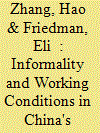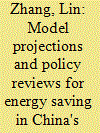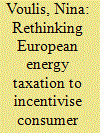|
|
|
Sort Order |
|
|
|
Items / Page
|
|
|
|
|
|
|
| Srl | Item |
| 1 |
ID:
088274


|
|
|
|
|
| Publication |
2009.
|
| Summary/Abstract |
This paper analyzes the changes in the energy consumption of the service sector in France over the period 1995-2006, using the logarithmic mean Divisia index I (LMDI I) decomposition method. The analysis is carried out at various disaggregation levels to highlight the specifics of each sub-sector and end-use according to their respective determinants. The results show that in this period the economic growth of the service sector was the main factor that led to the increase in total energy consumption. Structure, productivity, substitution and intensity effects restricted this growth, but with limited effect. By analyzing each end-use, this paper enables a more precise understanding of the impact of these factors. The activity effect was the main determinant of the increase in energy consumption for all end-uses except for air conditioning, for which the equipment rate effect was the main factor. Structural changes in the service sector primarily impacted energy consumption for space heating and cooking. Improvements in productivity limited the growth of energy consumption for all end-uses except for cooking. Finally, energy efficiency improvements mainly affected space-heating energy use.
|
|
|
|
|
|
|
|
|
|
|
|
|
|
|
|
| 2 |
ID:
145173


|
|
|
|
|
| Publication |
New Delhi, Govt. Publications, 2016.
|
| Description |
vii, 213p.+ A1-A163pbk
|
|
|
|
|
|
|
|
|
|
|
|
Copies: C:1/I:0,R:0,Q:0
Circulation
| Accession# | Call# | Current Location | Status | Policy | Location |
| 058672 | 338.954/IND 058672 | Main | On Shelf | General | |
|
|
|
|
| 3 |
ID:
171367


|
|
|
|
|
| Summary/Abstract |
To accommodate the increasing share of intermittent renewable energy, options need to be evaluated to maintain a profitable, secure and sustainable energy supply. Besides energy efficiency (EE) as “first fuel”, adapting demand to meet the variable supply needs to be evaluated. We focus on concepts of energy efficiency and load flexibility (further: demand response; DR) and compare the two types of measures with respect to the diffusion of actions taken and possible drivers and barriers affecting uptake, we derive recommendations to promote the measures more effectively and synergistically. We analyse the results of a survey of more than 1500 service sector companies in Germany and supplement the results with research on German policies promoting energy efficiency and how these could also promote DR. We use logistic regression models to assess and compare influencing factors. Energy efficiency measures are much more prevalent than demand response measures, while most of the influencing factors for both are comparable. More information and standardisation will be needed to tap the demand response potential. We assume that the successful instruments and policies for energy efficiency could also be applied to foster demand response. Especially, instruments such as Energy Efficiency Networks could be redesigned to include demand response. The same holds for other established, effective regulatory instruments like energy audits, which could be enhanced by adding demand response. Although energy efficiency and demand response measures might counteract in specific cases, promoting DR measures can to a large extent built synergistically on existing energy efficiency policy.
|
|
|
|
|
|
|
|
|
|
|
|
|
|
|
|
| 4 |
ID:
186390


|
|
|
|
|
| Summary/Abstract |
This research assesses the importance of financial access on value added in three economic sectors in 25 countries in Sub-Saharan Africa using data for the period 1980–2014. The empirical evidence is based on the Generalized Method of Moments. Financial access is measured with private domestic credit, while the three outcome variables are: value added in the agricultural, manufacturing, and service sectors, respectively. Enhancing financial access does not significantly improve value added in the agricultural and manufacturing sectors, while enhancing financial access improves value added in the service sector. An extended analysis shows that, in order for the positive net incidence of enhancing credit access on value added to the service sector to be maintained, complementary policies are required when domestic credit to the private sector is between 77.50 percent and 98.50 percent of GDP. Policy implications are discussed.
|
|
|
|
|
|
|
|
|
|
|
|
|
|
|
|
| 5 |
ID:
166872


|
|
|
|
|
| Summary/Abstract |
Drawing on ethnographic data from the sanitation industry in Wenzhou and Guangzhou, we investigate different patterns of work organization in each city. We find that supplementary informal work can serve to subsidize low family income and therefore stabilize formal but exploitative work. In Wenzhou, the family team model creates time and space for one spouse to engage in informal work while still receiving a wage from the employer. This additional informal work significantly increases net family income, which neutralizes worker demands for better wages and working conditions in the formal sector. In contrast, Guangzhou workers are subject to relatively rigid spatio-temporal controls, impeding them from participating in informal work to supplement their formal wages. Despite receiving higher wages and more benefits, these workers are highly wage dependent and express much greater discontent than their equivalents in Wenzhou. Theoretically, we contribute to the literature on informality through a discussion of “ancillary informal work,” highlighting how access to certain kinds of informal work both subsidizes and is facilitated by formal sector employment.
|
|
|
|
|
|
|
|
|
|
|
|
|
|
|
|
| 6 |
ID:
092430


|
|
|
|
|
| Publication |
2009.
|
| Summary/Abstract |
Drawing upon output, employment, consumption and trade data, this article examines whether there is an economic tertiarization trend in China 's economy and evaluates the common factors driving current trends. It shows that the tertiarization trend is evident for the overall economy and most regions in terms of the service nominal value-added ratio and service employment and consumption. However, the tertiarization trend is not significant in terms of the service real value-added ratio, and there is even some concurrent "detertiarization" because of the decreasing proportion of services in imports and exports. Indeed, China's tertiarization trend is far behind its industrialization trend. The rise in the relative prices of services explains the rising proportion of household service consumption expenditure and further illuminates why the service real value-added ratio has not grown. The main cause for the growing percentage of service employment is the lag in service labor productivity growth in interaction with the price inelasticity of service demand. "Cost disease" has appeared in service consumption.
|
|
|
|
|
|
|
|
|
|
|
|
|
|
|
|
| 7 |
ID:
133446


|
|
|
|
|
| Publication |
2014.
|
| Summary/Abstract |
There has been a growing concern about the issue of "jobless growth" in the Indian economy as a major problem to the enormous growth of GDP, growing at about 8.6% during the year 2005-2010. This paper takes a comprehensive investigation into India's as well as major Statewise economic growth and employment during the different NSS rounds, with a special reference to the service sector, the main growth engine for Indian economy over past two decades. This paper tries to examine the factors accounting for the growth in the Indian economy through the labour market and workforce behavior.
|
|
|
|
|
|
|
|
|
|
|
|
|
|
|
|
| 8 |
ID:
136063


|
|
|
|
|
| Summary/Abstract |
Despite of the fact that poverty is one of the major issues concerning policy makers, it has received less attention with respect to its linkages with services sector growth. In this research study, an attempt was made to quantitatively explore the nexus between growth in services sector of Pakistan and its poverty reducing impact. A time series data ranging from 1951 to 2010 were used in this study. The services sector was disaggregated into six sub-sectors. An Augmented Dickey–Fuller test was applied to check the stationarity of the data. An Auto-Regressive Distributed Lag approach to co-integration and error correction model was applied to estimate long- and short-run coefficients, respectively. The results of the study indicate that growth in wholesale and retail trade and the ownership of dwelling reduce poverty only in the short run. Growth in finance and insurance worsen poverty. The greatest impacts on poverty reduction occur as result of growth in community services (CS) and transportation, storage and communication (TSC). Among all variables, community services were found highly significant with the coefficients 0.62 and 0.308 in the long run and short run respectively. Therefore, it was concluded that relatively more stress should be given on community services such as education, and health, etc., in order to reduce poverty in Pakistan.
|
|
|
|
|
|
|
|
|
|
|
|
|
|
|
|
| 9 |
ID:
125418


|
|
|
|
|
| Publication |
2013.
|
| Summary/Abstract |
Energy efficiency of buildings in the service sector is becoming increasingly important in China due to the structural shift of the economy from industry to services. This paper employs a bottom-up cohort model to simulate current energy saving policies and to make projections for future energy use and CO2 emissions for the period 2000-2030 in the Chinese service sector. The analysis shows that energy demand in the service sector will approximately triple in 2030, far beyond the target of quadrupling GDP while only doubling energy use. However, it is feasible to achieve the target of emission reduction by 40% in 2020 even under the poor state of compliance rate of building standard. This paper also highlights four crucial aspects of designing optimal energy saving policies for China's service sector based on the model results.
|
|
|
|
|
|
|
|
|
|
|
|
|
|
|
|
| 10 |
ID:
082249


|
|
|
|
|
| Publication |
2008.
|
| Summary/Abstract |
The level of foreign direct investment (FDI) in the hotel sector of the tourism industry in Jamaica is unprecedented. This study seeks to understand the motivation for such investments using the extant theories of FDI as the conceptual framework. To achieve this aim, the study draws on the qualitative analysis of data gathered through face-to-face interviews with hotel managers, government policy makers and ambassadors from the investing countries to shed light on the issue. The conclusions reveal that intense competition in the home market has forced the multinational enterprise to seek markets abroad. Jamaica was chosen as a location because of its proximity to the US market and also the level of infrastructure development in the economy. However, because of the service-oriented nature of these multinational enterprises, the investors opted for FDI instead of other entry modes. These FDIs have changed the structure of the tourism industry in Jamaica and have led to increased levels of competition in the industry which, this study argues; is healthy for improved competitiveness in the industry
|
|
|
|
|
|
|
|
|
|
|
|
|
|
|
|
| 11 |
ID:
162896


|
|
|
|
|
| Summary/Abstract |
The European Union considers demand response to be an integral part of its future energy vision, in particular as a supporting mechanism for renewable resource integration. To achieve high demand response participation, the European Union recognises the need for adequate financial incentives for all consumers, especially for residential and service sector consumers. However, the European Energy Tax Directive, which regulates energy taxation in the European Union, is currently not in alignment with this vision, as it does not provide any financial incentives for demand response participation. This paper explores the potential of energy taxes to provide such incentives. First, through an analysis of the current energy taxation and demand response literature. Second, by quantifying the difference in financial incentives between two tax designs (per-unit and ad valorem taxes) in a simulation case study of consumers heat pumps in the Netherlands. Results show that financial incentives are 3.5 times higher for the ad valorem tax than for the per-unit tax. The paper concludes with recommendations for policy makers for the design of energy taxes that provide residential and service sector consumers with adequate financial incentives for demand response participation.
|
|
|
|
|
|
|
|
|
|
|
|
|
|
|
|
| 12 |
ID:
152938


|
|
|
|
|
| Summary/Abstract |
The aim of this paper is to investigate how new rules and practices in multilateral, regional and bilateral trade negotiations related to the services industries can be adopted and implemented at the business level, using the recently concluded free-trade agreement (FTA) negotiations between the EU and Singapore as an illustrative case. The purpose is to put the services sector into the larger framework of business service interaction between the EU and the outside world by identifying crucial sub-sectors within the services industries and their relations to physical, ‘visible’ production and trade. Furthermore, to assess the prospects of ‘multilateralising’ regional trade agreements within the service sector, through the ambitions by both parties to make bilateral and interregional FTAs and EPAs more compatible and mutually comparable with the multilateral GATS’ rules. The EU-Singapore FTA is an agreement that became a ‘second-best’ solution of the stalled interregional EU-ASEAN negotiation, taking place 2006–2009. It can nevertheless be seen as a ‘WTO-plus’ endeavour, since it aims at reaching beyond what is under negotiation in the likewise stalled Doha Development Agenda within the WTO framework, particularly in the fields of business services, public procurement, intellectual property rights, trade-related investment measures, and, generally, competition rules. Since both parties already apply low or zero tariffs in most sectors of manufacturing, the main issues in the negotiations were related to services in general and knowledge-intensive business services in particular, with an emphasis on technical barriers to trade.
|
|
|
|
|
|
|
|
|
|
|
|
|
|
|
|
| 13 |
ID:
183740


|
|
|
|
|
| Summary/Abstract |
The article presents differences in firm-level total factor productivity in the information technology (IT) service firms in India over the period 2000–2016. It is an attempt to study whether technological efforts contribute to productivity differences in the firms in conjunction with several other firm specific characteristics. Controlling for endogeneity in inputs, the estimation of productivity through semi-parametric techniques indicates considerable heterogeneity in productivity across firm types. Technological efforts of firms have a significant impact on the productivity of IT firms. Both embodied technology imports and in-house R&D contribute to higher productivity. While the Indian firms are observed to be more productive compared to their foreign counterparts, the technological efforts also differ due to ownership factors and that contributes to changes in productivity.
|
|
|
|
|
|
|
|
|
|
|
|
|
|
|
|
| 14 |
ID:
126367


|
|
|
|
|
|
|
|